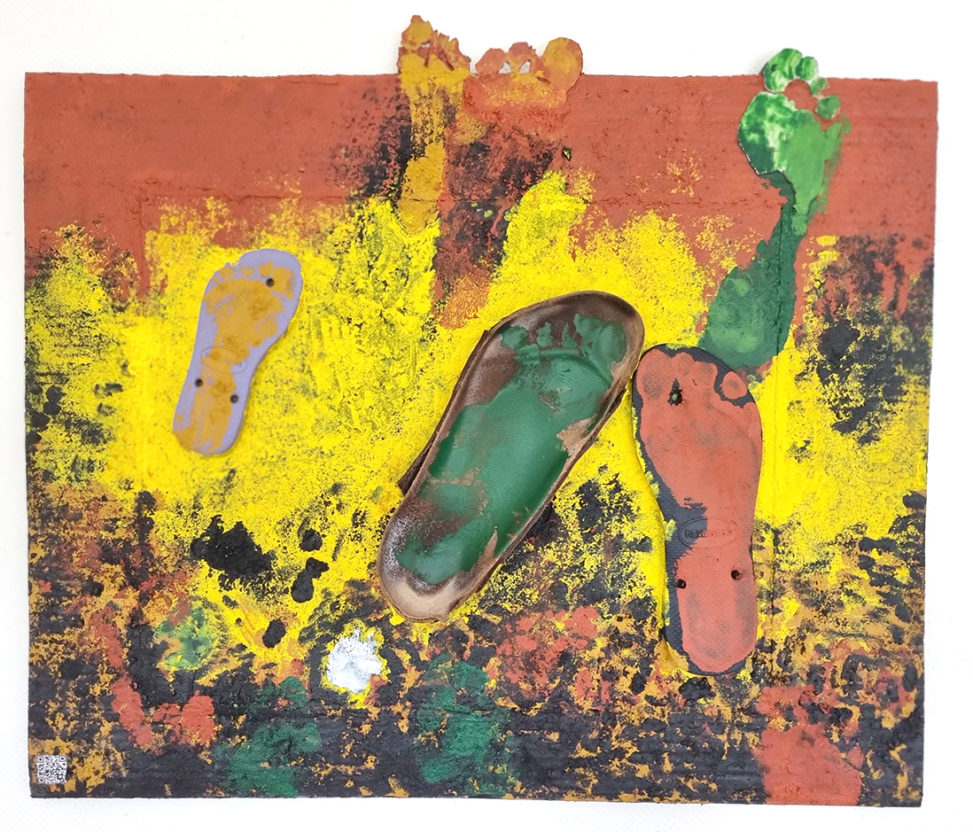Artwork title: DRD4-7R
Author: Gringo
Created: from January to May 2025
Size: 71 cm x 58 cm
Materials: Acrylic, industrial footwear soles, ferrous pigments, metal and acrylic varnish on synthetic wood and packaging cardboard
This work of art called DRD4-7R aims to alert humanity considering our nomadic past and genetic adaptations.
Drawing from Anthony Sattin’s insights on the history of nomads and the recent genetic research on the dopamine receptor D4 (DRD4) gene, particularly the 7 repeat (7R) allele, a significant warning for humanity emerges: humankind risks losing crucial perspectives and adaptive traits essential for a prosperous and sustainable future by neglecting the history and wisdom of nomadic peoples, misunderstanding the potential implications of our genetic heritage related to mobility, and by overlooking the consequences of our disconnection from the natural world and our ongoing adaptation to a sedentary existence.
Key Points Revealed by Anthony Sattin
This comprehensive warning integrates findings from both Anthony Sattin’s perspective on nomadic history and the specific genetic research detailed in the sources at the end:
- The Overlooked Legacy and Wisdom of Nomads: As Anthony Sattin argues, settled societies often fail to recognize the profound influence and contributions of nomadic cultures throughout history. This oversight can lead to a diminished understanding of human resilience, resourcefulness, and sustainable practices. The new research on the DRD4 7R allele, which has been found at higher frequencies in populations with a history of long-term migrations, potentially underscores a genetic component linked to this historically significant mobile lifestyle. Neglecting the perspectives of these historically migratory populations means potentially ignoring valuable knowledge honed over millennia of interaction with diverse environments.
- Genetic Underpinnings of Mobility and Adaptation: The research on the DRD4 7R allele suggests a possible genetic basis for traits associated with migration. This allele has been linked to behavioral traits such as attention deficit hyperactivity disorder (ADHD), impulsivity, financial risk-taking, and novelty seeking. Intriguingly, the study indicates tentative support for an association between multiple ancestries and the 7R allele, potentially reflecting past migratory patterns and mate choice. This suggests that our evolutionary history of mobility may have left genetic markers that influence behavior in ways that might be perceived differently in sedentary versus nomadic contexts.
- The Sedentary Transition and Potential Mismatches: Our relatively recent transition to predominantly sedentary lifestyles, within the last 12,000 years, may not align perfectly with certain aspects of our genetic heritage shaped by millennia of nomadic existence. The connection of the 7R allele to traits sometimes seen as challenges in sedentary societies (like ADHD) but potentially advantageous in mobile, unpredictable environments (like novelty seeking and risk-taking) highlights this potential mismatchregarding convergent vs. divergent thinking] Failing to recognize these underlying genetic inclinations could lead to misunderstandings and potentially suboptimal societal structures.
- The Critical Need for Diverse Perspectives and Adaptability: Just as nomadic life necessitated divergent thinking and adaptability, the complexities of the modern world demand similar cognitive flexibility. The potential link between the DRD4 7R allele and novelty seeking might reflect an evolutionary advantage for exploring new territories and solutions – a trait that remains crucial for addressing contemporary global challenges. Overemphasizing convergent thinking in sedentary environments while overlooking the value of divergent perspectives, potentially linked to our genetic past, could limit our capacity for innovation and problem-solving.
- The Ongoing Significance of Interconnectedness and Openness: Historically, migration and the mixing of populations, potentially facilitated by those with a propensity for movement possibly linked to genes like DRD4, have been drivers of cultural exchange and progress. The study’s exploration of assortative mating and ancestry underscores the historical and ongoing importance of intermingling. Erecting barriers to the free flow of people and ideas, in opposition to this historical pattern, could stifle innovation and understanding.
And much, much more…
This Fair Warning touch upon a central point in the discussion about nomadism and human adaptation, particularly in relation to the DRD4-7R gene. The consequences of the DRD4-7R gene being a product of evolution, conferring abilities well-suited to nomadic circumstances, are multifaceted.
Evolutionary Advantages in Nomadic Contexts
- History of Migration: The higher frequency of the 7R allele in populations with a history of long-distance migrations suggests that it conferred advantages in environments where mobility was crucial.
- Associated Behaviors: The 7R allele has been associated with behavioral traits such as novelty seeking, impulsivity, and a greater propensity for risk-taking. In a nomadic lifestyle, these characteristics could have been advantageous for exploring new territories, finding resources, and dealing with the constant uncertainty of the environment.
- Success in Nomadic Lifestyle: There is evidence suggesting that the 7R allele may be linked to greater success in a nomadic lifestyle. Research with contemporary nomadic populations, such as the Ariaal people in East Africa, found a genetic variant associated with success in nomadism, which is the same one found in children diagnosed with learning difficulties and ADHD in sedentary societies.
- Divergent Thinking: Nomadic life required and fostered divergent thinking, with the need to consider multiple options and solutions for daily challenges in an uncontrolled environment. Individuals with certain genetic predispositions, such as the DRD4-7R, might have excelled in this way of thinking.
Transition to Sedentary Life and Consequences
- Disadvantages in Sedentary Environments: With the advent of sedentary life and the increasing emphasis on convergent thinking (a single correct answer), many of the advantages associated with the 7R allele can turn into disadvantages.
- Attention Deficit Hyperactivity Disorder (ADHD): The association of 7R with ADHD is a classic example. In a nomadic environment, the ability to quickly shift focus to new information and the impulsiveness to explore could be useful. However, in a classroom or a sedentary work environment, these same characteristics can lead to difficulties in concentration and behavior.
- Inadequacy of the Environment: The observation that the problem may not be the individual but the inadequate environment is supported by the idea that the brains of individuals with this genetic predisposition may be “wired” for a lifestyle in motion and for more divergent thinking. The expectation of living and thinking in a completely different way in a sedentary environment may be the root of the difficulties faced.
- Loss of Connection with the Natural World: The transition to sedentary life, especially in urban environments, often results in a loss of connection with the natural world and an understanding of its dynamics. Nomads, due to their total dependence on the environment, develop a deep knowledge about it. The valuation of traits once adaptive as “disorders” perhaps reflects this disconnection and a narrow view of what constitutes “normal” functioning.
In summary, the DRD4-7R gene, likely selected for its advantages in nomadic contexts that required mobility, exploration, and divergent thinking, can lead to challenges and be categorized as a disorder (such as ADHD) in sedentary environments that value stability, sustained concentration, and convergent thinking. This perspective suggests that how we define “normality” and “disease” may be intrinsically linked to the social environment and the predominant lifestyle.
Sources consulted
- Sattin, Anthony. Nomads: The Wanderers Who Shaped Our World. New York: Pegasus Books, 2022.
- Eisenberg, D. T. A., Campbell, B., MacKillop, J., et al. (2010). Pair bonds, ancestry and the DRD4 gene. SCAN, 5(2), 196-201.
- Dopamine receptor D4 – en.wikipedia.org/wiki/Dopamine_receptor_D4 (Monday, April 21, 5:39 PM CET)


Leave a Reply